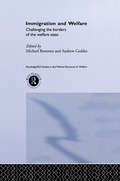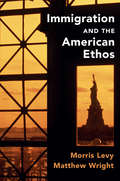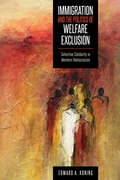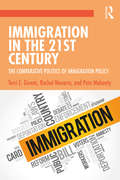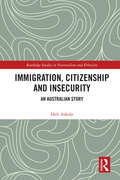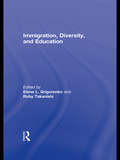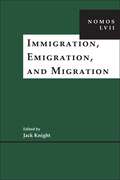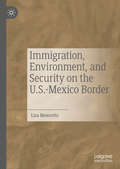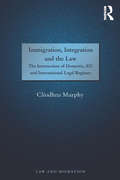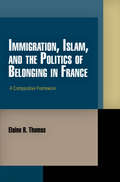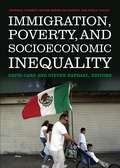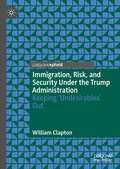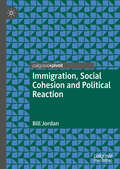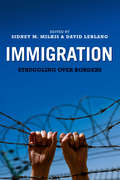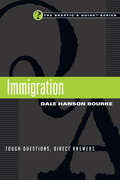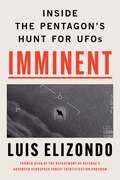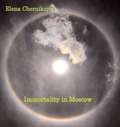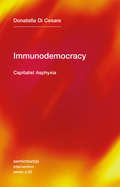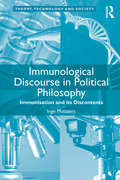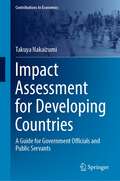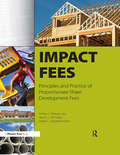- Table View
- List View
Immigration and Welfare: Challenging the Borders of the Welfare State (Routledge Studies In The Political Economy Of The Welfare State Ser.)
by Andrew Geddes Michael BommesImmigration and Welfare avoids simplistic and unhelpful notions of the 'threat' of immigration to analyse the effects of immigration on national welfare states in an integrating Europe. It explores new migration challenges, such as asylum seekers and Europe's increasingly restrictive immigration policies, and looks at the implications of such debat
Immigration and the American Ethos (Cambridge Studies in Public Opinion and Political Psychology)
by Matthew Wright Morris LevyWhat do Americans want from immigration policy and why? In the rise of a polarized and acrimonious immigration debate, leading accounts see racial anxieties and disputes over the meaning of American nationhood coming to a head. The resurgence of parochial identities has breathed new life into old worries about the vulnerability of the American Creed. This book tells a different story, one in which creedal values remain hard at work in shaping ordinary Americans' judgements about immigration. Levy and Wright show that perceptions of civic fairness - based on multiple, often competing values deeply rooted in the country's political culture - are the dominant guideposts by which most Americans navigate immigration controversies most of the time and explain why so many Americans simultaneously hold a mix of pro-immigrant and anti-immigrant positions. The authors test the relevance and force of the theory over time and across issue domains.
Immigration and the Politics of Welfare Exclusion: Selective Solidarity in Western Democracies (Studies in Comparative Political Economy and Public Policy)
by Edward A. KoningWhy do some governments try to limit immigrants’ access to social benefits and entitlements while others do not? Through an in-depth study of Sweden, Canada, and the Netherlands, Immigration and the Politics of Welfare Exclusion maps the politics of immigrants’ social rights in Western democracies. To achieve this goal, Edward A. Koning analyzes policy documents, public opinion surveys, data on welfare use, parliamentary debates, and interviews with politicians and key players in the three countries. Koning’s findings are three-fold. First, the politics of immigrant welfare exclusion have little to do with economic factors and are more about general opposition to immigration and multiculturalism. Second, proposals for exclusion are particularly likely to arise in a political climate that incentivizes politicians to appear "tough" on immigration. Finally, the success of anti-immigrant politicians in bringing about exclusionary reforms depends on the response of the political mainstream, and the extent to which immigrants’ rights are protected in national and international legal frameworks. A timely investigation into an increasingly pressing subject, Immigration and the Politics of Welfare Exclusion will be essential reading for scholars and students of political science, comparative politics, and immigration studies.
Immigration in the 21st Century: The Comparative Politics of Immigration Policy
by Terri E. Givens Rachel Navarre Pete MohantyImmigration policy is one of the most contentious issues facing policy makers in the twenty-first century. Immigration in the Twenty-First Century provides students with an in-depth introduction to the politics that have led to the development of different approaches over time to immigration policy in North America, Europe, and Australia. The authors draw on the work of the most respected researchers in the field of immigration politics as well as providing insights from their own research. The book begins by giving students an overview of the theoretical approaches used by political scientists and other social scientists to analyze immigration politics, as well as providing historical background to the policies that are affecting electoral politics. A comparative politics approach is used to develop the context that explains the ways that immigration has affected politics and how politics has affected immigration policy in migrant-receiving countries. Topics such as party politics, labor migration, and citizenship are examined to provide a broad basis for understanding policy changes over time. Immigration remains a contentious issue, not only in American politics, but around the globe. The authors describe the way that immigrants are integrated, their ability to become citizens, and their role in democratic politics. This broad-ranging yet concise book allows students to gain a better understanding of the complexities of immigration politics and the political forces defining policy today. Features of this Innovative Text Covers hot topics including party politics, labor migration, assimilation, and citizenship both in the United States as well as globally. Consistent chapter pedagogy includes chapter introductions, conclusions, key terms and references. An author-hosted Website is updated regularly: www.terrigivens.com/immigration
Immigration, Citizenship and Insecurity: An Australian Story (Routledge Studies in Nationalism and Ethnicity)
by Heli AskolaImmigration, Citizenship and Insecurity: An Australian Story explores how Australia’s policies on migration and nationality have shaped citizenship and social inclusion.The book examines the historical and contemporary intersections of citizenship, migration and insecurity, analysing key issues such as the prioritisation of economic utility in migration policy, cultural expectations placed on newcomers and the role of migrants in political debate. It critically assesses Australia’s responses to challenges such as demographic ageing, cultural diversity and erosion of political authority. The impact of emergency measures during the COVID-19 pandemic is also explored, revealing the fragility of citizenship protections in times of crisis.This book is an essential resource for scholars, policy-makers and professionals in migration studies, political science and public policy, as well as anyone interested in the evolving dynamics of citizenship and migration in Australia and beyond.
Immigration, Diversity, and Education
by Elena L. Grigorenko Ruby TakanishiThis edited volume presents an overview of research and policy issues pertaining to children from birth to 10 who are first- and second-generation immigrants to the U.S., as well as native-born children of immigrants. The contributors offer interdisciplinary perspectives on recent developments and research findings on children of immigrants. By accessibly presenting research findings and policy considerations in the field, this collection lays the foundation for changes in child and youth policies associated with the shifting ethnic, cultural, and linguistic profile of the U.S. population.
Immigration, Emigration, and Migration: NOMOS LVII (NOMOS - American Society for Political and Legal Philosophy #15)
by Jack KnightImmigration, Emigration and Migration consists of essays written by distinguished scholars across the fields of law, political science, and philosophy that examine questions of travel and migration across national borders. Questions of immigration and border enforcement practices are particularly salient in contemporary public discourse, and examinations of policy and practice bring forth new philosophical quandaries. Why the common assumption that each country has the right to control its own borders? How are laws that restrict or regulate migration created and justified? Why has the criminalization of migration increased? How can migration be better considered through the point of view of the migrants themselves? What are the differences in international and national institutional migratory policy? The volume explores questions of border control and enforcement, criminalization of borders, and how to address current debates and changes in regards to migration and immigration. The intersection of analysis and prescription provides both an assessment of current forms of thought or regulation and suggestion of alterations to address the flaws or failures of present approaches. The eight essays in this volume reflect a variety of considerations and explorations across interdisciplinary lines, and provide a new and thought-provoking discussion of policy, practice, and philosophy of migratory and border practices.
Immigration, Environment, and Security on the U.S.-Mexico Border
by Lisa MeierottoThis book examines the convergence of conservation and security efforts along the U.S.-Mexico border in Arizona. The author presents a unique analysis of the history of Cabeza Prieta National Wildlife Refuge, a federally protected border wilderness area. Beginning in the early 1990s, changes to U.S. immigration policy dramatically altered the political and natural landscape in and around Cabeza Prieta. In particular, the increasing presence of Border Patrol has contributed to environmental degradation in wilderness. Complicated human rights concerns are also explored in the book. Protecting wildlife in an area with high rates of undocumented border-crossing and smuggling results in complex and sometimes controversial conservation policies. Ultimately, the observations and analysis presented in this book illustrate ways in which the politics of race and nationalism are subtly, but significantly, interwoven into border environmental and security policies.
Immigration, Integration and the Law: The Intersection of Domestic, EU and International Legal Regimes (Law and Migration)
by Clíodhna MurphyThis book examines the role and impact of EU, international human rights and refugee law on national laws and policies for integration and argues for a broad understanding of the relationship between integration and the law. It analyses the legal foundations of integration at the international and regional levels and examines the interaction of national, EU and international legal spheres, highlighting the significance of these dimensions of the relationship between integration and the law. The book draws together these central themes to enhance our understanding of the connections between integration and the law. It also makes specific recommendations for the development of holistic, human-rights based approaches to integration in EU Member States. The book will be of value to academics and researchers working in the areas of immigration, and refugee law, as well as those interested in cultural diversity both from a legal and sociological perspective.
Immigration, Islam, and the Politics of Belonging in France: A Comparative Framework (Pennsylvania Studies in Human Rights)
by Elaine R. ThomasOver the past three decades, neither France's treatment of Muslims nor changes in French, British, and German immigration laws have confirmed multiculturalist hopes or postnationalist expectations. Yet analyses positing unified national models also fall short in explaining contemporary issues of national and cultural identity. Immigration, Islam, and the Politics of Belonging in France: A Comparative Framework presents a more productive, multifaceted view of citizenship and nationality.Political scientist Elaine R. Thomas casts new light on recent conflicts over citizenship and national identity in France, as well as such contentious policies as laws restricting Muslim headscarves. Drawing on key methods and insights of ordinary language philosophers from Austin to Wittgenstein, Thomas looks at parliamentary debates, print journalism, radio and television transcripts, official government reports, legislation, and other primary sources related to the rights and status of immigrants and their descendants. Her analysis of French discourse shows how political strategies and varied ideas of membership have intertwined in France since the late 1970s. Thomas tracks the crystallization of a restrictive but apparently consensual interpretation of French republicanism, arguing that its ideals are increasingly strained, even as they remain politically powerful. Thomas also examines issues of Islam, immigration, and culture in other settings, including Britain and Germany.Immigration, Islam, and the Politics of Belonging in France gives scholarly researchers, political observers, and human rights advocates tools for better characterizing and comparing the theoretical stakes of immigration and integration and advances our understanding of an increasingly significant aspect of ethnic and religious politics in France, Europe, and beyond.
Immigration, Popular Culture, and the Re-routing of European Muslim Identity
by Lara N. Dotson-RentaThrough readings of postcolonial theory and examination of post-9/11 novels, film, and hip-hop music, this book studies how North African immigrants to Spain translate and transfer cultural and political memory from one land to another.
Immigration, Poverty, and Socioeconomic Inequality
by David Card Steven RaphaelThe rapid rise in the proportion of foreign-born residents in the United States since the mid-1960s is one of the most important demographic events of the past fifty years. The increase in immigration, especially among the less-skilled and less-educated, has prompted fears that the newcomers may have depressed the wages and employment of the native-born, burdened state and local budgets, and slowed the U.S. economy as a whole. Would the poverty rate be lower in the absence of immigration? How does the undocumented status of an increasing segment of the foreign-born population impact wages in the United States? In Immigration, Poverty, and Socioeconomic Inequality, noted labor economists David Card and Steven Raphael and an interdisciplinary team of scholars provide a comprehensive assessment of the costs and benefits of the latest era of immigration to the United States Immigration, Poverty, and Socioeconomic Inequality rigorously explores shifts in population trends, labor market competition, and socioeconomic segregation to investigate how the recent rise in immigration affects economic disadvantage in the United States. Giovanni Peri analyzes the changing skill composition of immigrants to the United States over the past two decades to assess their impact on the labor market outcomes of native-born workers. Despite concerns over labor market competition, he shows that the overall effect has been benign for most native groups. Moreover, immigration appears to have had negligible impacts on native poverty rates. Ethan Lewis examines whether differences in English proficiency explain this lack of competition between immigrant and native-born workers. He finds that parallel Spanish-speaking labor markets emerge in areas where Spanish speakers are sufficiently numerous, thereby limiting the impact of immigration on the wages of native-born residents. While the increase in the number of immigrants may not necessarily hurt the job prospects of native-born workers, low-skilled migration appears to suppress the wages of immigrants themselves. Michael Stoll shows that linguistic isolation and residential crowding in specific metropolitan areas has contributed to high poverty rates among immigrants. Have these economic disadvantages among low-skilled immigrants increased their dependence on the U.S. social safety net? Marianne Bitler and Hilary Hoynes analyze the consequences of welfare reform, which limited eligibility for major cash assistance programs. Their analysis documents sizable declines in program participation for foreign-born families since the 1990s and suggests that the safety net has become less effective in lowering child poverty among immigrant households. As the debate over immigration reform reemerges on the national agenda, Immigration, Poverty, and Socioeconomic Inequality provides a timely and authoritative review of the immigrant experience in the United States. With its wealth of data and intriguing hypotheses, the volume is an essential addition to the field of immigration studies. A Volume in the National Poverty Center Series on Poverty and Public Policy
Immigration, Risk, and Security Under the Trump Administration: Keeping ‘Undesirables’ Out
by William ClaptonThis book explores the immigration policies and practices of the Trump administration, with a specific focus on Trump’s travel ban and the wall along the southern border with Mexico. Both were enacted shortly after Trump was elected President. It examines how the Trump administration defined and represented immigration as an issue of national security and why it sought to address the perceived security challenges posed by immigration through the specific forms of a travel ban and a wall along the southern border. The main argument advanced is that a logic of risk underpinned the Trump administration’s approach to immigration and national security. Employing the framework of riskisation, this book explores the embodied, racialised, and gendered construction and representation of risk, political and popular resistance to Trump’s wall and travel ban, and the social and political consequences of both.
Immigration, Social Cohesion and Political Reaction
by Bill JordanThis book addresses the challenge for social integration posed by immigration into Western liberal democracies. Movement of people, goods and money across borders has increased in recent decades – the phenomenon known as globalisation. But it has been the migration of refugees from civil wars in the Middle East which has most transformed the political life of European societies, causing the decline in support for the traditional conservative and social democratic parties. It has triggered nationalistic mobilisations and authoritarian regimes, as well as attempts to improved integration in societies. The coronavirus pandemic has added a dimension to these processes, but also opened up new possibilities for transformation.
Immigration: Struggling over Borders (Miller Center Studies on the Presidency #Vol. 2)
by Daniel J. Tichenor David A. Martin Anna O. Law Gary FreemanIn an increasingly polarized political environment, the first year of the new president’s term will be especially challenging. With a fresh mandate, however, the first year also offers opportunities that may never come again. The First Year Project is a fascinating initiative by the Miller Center of the University of Virginia that brings together top scholars on the American presidency and experienced officials to explore the first twelve months of past administrations, and draw practical lessons from that history, as we inaugurate a new president in January 2017.This project is the basis for a new series of digital shorts published as Miller Center Studies on the Presidency. Presented as specially priced collections published exclusively in an ebook format, these timely examinations recognize the experiences of past presidents as an invaluable resource that can edify and instruct the incoming president.Contributors: Anno O. Law, Brooklyn College * David A. Martin, University of Virginia * Gary Freeman, University of Texas at Austin * Daniel Tichenor, University of Oregon * David Leblang and Sidney Milkis, University of Virginia
Immigration: Tough Questions, Direct Answers (The Skeptic's Guide Series)
by Dale Hanson BourkeHow can we be sure terrorists aren't entering our country? What does it mean to be a citizen? Do immigrants help or hurt the economy? What's wrong with calling someone an illegal immigrant? In this Skeptic's Guide™ Dale Hanson Bourke sheds light on key terms and concepts, historical events and current concerns that drive the immigration debate. Such a complex issue offers no easy answers, but with charts and photos, facts and quotes, this dynamic guide sheds light without adding heat to the most important questions—a hallmark of the Skeptic's Guide series, making it a valuable resource for individuals and groups.
Imminent Threat
by Jeff GunhusA family of spies. A network of killers. A treacherous, planned attack on the world&’s most powerful leaders—and the final countdown to Armageddon . . . Jacobslav Scarvan is supposed to be dead. Once a ruthless assassin for the KGB, he went too far when he burned a family alive for the sheer pleasure of it—and became a target himself. Both the CIA and Russian intelligence wanted him eliminated. CIA agent Scott Roberts was the man to do it. Three bullets should have been enough to kill Scarvan. But it only forced the rogue agent deeper underground—to places that will forever haunt him . . . Twenty years later Scott and his daughter Mara are working for the US president, using their joint experience to form an elite Alpha Team of highly skilled operatives. Their mission is to hunt down and destroy the apocalyptic shadow organization known as Omega. But when they learn that Scarvan is still alive—plotting revenge after undergoing a twisted radicalization that makes him more dangerous than ever—Scott and Mara must race across the globe to prevent an epic disaster. This time, when the clock runs out, the end times begin . . . &“With an alpha female heroine and a tantalizing premise, this hard-edged, gripping thriller matches wits and wiles, delivering an entertaining romp.&”—Steve Berry, New York Times bestselling author on Silent Threat Visit us at www.kensingtonbooks.com
Imminent: Inside the Pentagon's Hunt for UFOs
by Luis ElizondoThe former head of the Pentagon program responsible for the investigation of UFOs—now known as unidentified anomalous phenomena (UAP)—reveals long-hidden secrets with profound implications for not only national security but our understanding of the universe. <P><P> Luis “Lue” Elizondo is a former senior intelligence official and special agent who was recruited into strange and highly sensitive US government program to investigate UAP. To accomplish his mission, Elizondo had to rely on decades of experience gained working some of America’s most classified programs. Even then, he was not prepared for what he would learn, including the truth about the government’s long shadowy involvement in UAP investigations, and the lengths officials would take to keep it a secret. <P><P> For years, Elizondo and his colleagues found themselves on the front lines of what may be the greatest mystery and cover-up in history. Unidentified craft that seem to defy our knowledge of physics**—within air, water, and space—**have been operating with complete impunity since at least World War II. The military, the CIA, and even past presidents have known the truth that humanity is, in fact, not the only intelligent life in the universe. The nonhuman intelligence controlling these UAP are actively conducting surveillance on our most sensitive military installations, and have interfered with ongoing military and nuclear operations. US service members and intelligence officers who have encountered UAP have sustained serious medical injuries. And all of this is happening worldwide. <P><P> The stakes could not be higher. Imminent is a first-hand, revelatory account inside the Pentagon’s most closely guarded secret and a call to action to confront humanity’s greatest existential questions. <p> <b>New York Times Bestseller</b>
Immortali a Mosca
by Elena ČernikovaRomanzo-avventura. La famiglia Užov si è contagiata con l'immortalità. Comincia un'epidemia. Ognuno riceve secondo i meriti...
Immortality in Moscow
by Elena ChernikovaThe novel describes the extraordinary adventures of people and animals infected with immortality.
Immunodemocracy: Capitalist Asphyxia (Semiotext(e) / Intervention Series #30)
by Donatella Di CesareA stimulating and profound portrayal of the epochal event that has already left its mark on the twenty-first century.Immunodemocracy offers a stimulating and profound portrayal of the epochal event that has already left its mark on the twenty-first century. Moving from the ecological question to the rule of experts, from the state of exception to immunitarian democracy, from rule by fear to the contagion of conspiracy theory, from forced distancing to digital control, Donatella Di Cesare examines how existence is already changing--and what its future political effects may be. In her own personal style, the author reconstructs the dramatic phases of what she calls "the breathing catastrophe." Coronavirus is a sovereign virus that skirts its way around the walls of patriotism and the sovereignists' imperious frontiers. And it reveals in all its terrible crudeness the immunitarian logic that excludes the weakest and hits the poorest. The Cordon sanitaire of disengagement risks expanding beyond all proportion. The disparity between the protected and the helpless--a challenge to any idea of justice--has never been so blatant. The virus has not introduced, but merely brought out into the open the ruthlessness of the capitalism that is now wrapping us in its devastating spiral, in its compulsive, asphyxial vortex. Is it our final warning? The violent global pandemic shows that it is impossible for us to survive if we don't help each other. We will need to protect ourselves from protection and the specter of absolute immunization. When breathing can no longer be taken for granted, we need to rethink a new way of living together.
Immunological Discourse in Political Philosophy: Immunisation and its Discontents (Theory, Technology and Society)
by Inge MutsaersGiven the propensity of contemporary protection measures such as counterterrorism efforts and fierce protection strategies against viral threats, as well as physical and legal barriers against migration, a number of political philosophers, including Peter Sloterdijk and Roberto Esposito, have claimed that contemporary (political) culture can be characterised by a so-called ’immunisation paradigm’. This book critically examines the intricate entanglement between biological immunological notions and their political philosophical appropriation, whilst studying the ’immunisation response’ to recent viral threats, including the Swine Flu pandemic of 2009 and the lab-bred Avian flu threat of 2012, to analyse immunisation as a biopolitical strategy. Offering insights into to the polarising tendencies in contemporary political culture resulting from the appropriation of immunological concepts in political thought, the author also shows how political philosophers tend to build on purely defensive understandings of immunity. As such, Immunological Discourse in Political Philosophy constitutes a theoretically sophisticated critique of the ’semantic trap’ caused by the use of immunological concepts in political philosophy. Arguing for a more versatile and less defensive immunological repertoire, which allows for the development of alternative and less polarised forms of political debate, this book will appeal to scholars of political theory, sociology, philosophy and science and technology studies.
Impact Assessment for Developing Countries: A Guide for Government Officials and Public Servants (Contributions to Economics)
by Takuya NakaizumiImpact Assessment (IA) is introduced in this book, with a guide to the process, scope, content, and management of IA for the governments of developing economies. In doing so, evidence-based policy making is taken into full consideration. After the principles of IA are set forth, its procedures are described, illustrated by typical cases from the United States and Japan. Then an explanation follows of the components of IA such as necessity, alternatives, and assessment of cost and benefit, with a description of competition assessment. In developing economies, it is not effective to simply import a system from developed countries directly into developing countries, especially for economic regulation and in consideration of compliance and competition issues. Thus the book provides recommendations on how to appropriately modify developed countries’ systems for countries that are still developing. The book concludes by taking up several issues surrounding IA, especially nudge theory and public involvement.
Impact ED: How Community College Entrepreneurship Creates Equity and Prosperity (Resetting Our Future)
by Andrew Gold Rebecca A. Corbin Mary Beth KerlyThis book provides leaders with insights into how entrepreneurial thinking and action can put local communities on the path to recovery from the economic devastation induced by the COVID-19 pandemic. Entrepreneurship offers a roadmap to the future. NACCE members colleges' newly evolved programs benefit local communities, fuel economic growth, and create more equitable opportunities for those who have been historically marginalized. This pathway leads to recovery, hope and a more caring, creative, and equitable society.
Impact Fees: Principles and Practice of Proportionate-Share Development Fees
by Author C NelsonThis is the only impact fee book you'll need for the next decade or longer! This comprehensive reference book updates the popular, pioneering works on impact fees by introducing new methodologies, concepts, applications, and theories. The authors contend that it's time to go beyond narrowly defined impact fees to proportionate-share development fees broadly applied to publicly provided facilities and services and their operation. Impact fees are one-time charges applied to new development to generate revenue for the construction or expansion of capital facilities outside the boundaries of the new development for system improvements engendered by the new development. At least that was the traditional use of impact fees. A generation ago, they were generally not used legally for the operation, maintenance, repair, alteration, or replacement of capital facilities; for social purposes such as affordable housing and daycare; or for "green" purposes such as habitat preservation. This book updates impact fee law, practice, and applications, and breaks new ground by showing how the impact fee logic of proportionate share can be used for these and other purposes. Through actual ordinances, summaries of technical reports, numerous case studies, and model ordinances and codes, readers will learn how to design and implement a proportionate-share development fee program. This is essential reading for anyone interested in impact fees.
